One of the most popular non-caffeinated Chinese teas, Pure Golden Osmanthus Tea (or 桂花茶 Gui Hua Cha) was part of the Chinese imperial palace's diet dating back to the Tang dynasty! If you want to drink what the royals drank, I've included 3 different versions of this fragrant tea below.
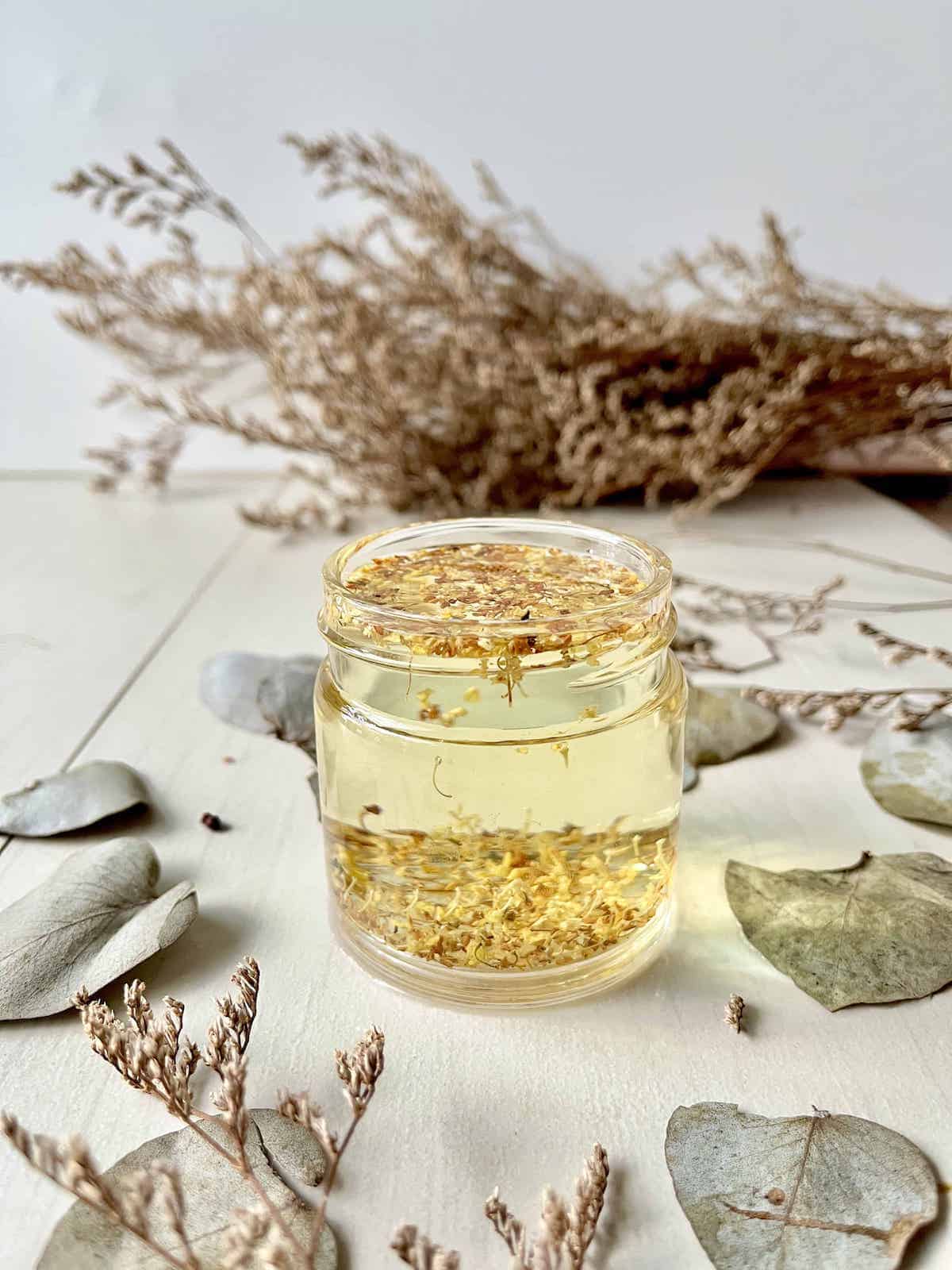
Jump to:
Why Make This
- Osmanthus tea is delicately delicious: with no caffeine, it has a floral flavor and is perfect for tea lovers with insomnia!
- This Chinese Herbal Tea also has potential health benefits: Traditional Chinese Medicine (TCM) has a reputation for not-being evidence-linked but I've found scientific studies that support the TCM claims (see "Health Benefits" below.)
- Not to mention, it's very pretty: the golden buds open into the most exquisite flowers in hot water!
What is Osmanthus?
In Chinese, osmanthus is called Gui Hua (桂花.)
Slightly reminiscent of elderflower in looks and fragrance, osmanthus is actually related to olives. Which is why osmanthus plants are also known as sweet olive, fragrant tea olive, olive osmanthus, fragrant olive, sweet osmanthus and osmanthus fragrans!
Originally from China, Indochina and South Japan, the flower is a classic Chinese fragrance dating back to the Tang Dynasty where it was used to brew pure tea and desserts such as osmanthus tea konnyaku jelly
You can even use it to make a flavoured osmanthus sugar to sweeten your tea and foods!
Taste
The dried golden flowers have rich aromas, similar to a very ripe peach or apricot. If you smell it, it's almost like honey!
The flavor when ingested, in contrast, is quite delicate and floral. It obviously tastes good to Chinese people, having been part of the cuisine for some long, but may be an acquired taste for those not used to floral flavours or the lighter taste of Asian desserts.
Note: Asian desserts, such as the chewy texture of mochi, can be love-it-or-hate-it!
In Chinese culture
Fresh Osmanthus flowers bloom from late summer to autumn. It thus has strong associations with the Chinese Harvest Festival or Mid-Autumn Festival, which falls on the 15th day of the 8th month in the lunar calendar.
Thus, we have several Mid-Autumn recipes which feature Osmanthus, such as glutinous rice tang yuan, osmanthus wine and even jam.
Fresh osmamthus flowers are so entrenched in Chinese culture that they are even part of a Chinese idiom 吳剛伐桂 (wu gang dai gui.) This phrase symbolises endless toil. (It references the Chinese myth in which a man, Wu Gang, has to chop down a regenerating osmanthus tree on the Moon. Sort of like a Chinese Sisyphus!
There are a few versions of the story, so I won't bore you but if you're interested, you can check out wikipedia.)
Health benefits
Note: this is just for your information and is not meant as medical, dietary or health advice, which I'm not qualified to give! Please check with the appropriate professionals if you have any questions or concerns about the benefits of osmanthus.
Some parts of TCM can be controversial so I only include it in my posts when there are authoritative sources, such as the local Singaporean Newspaper or scientific reports.
Osmanthus flower tea and cake were popular with the Chinese royalty, as the flower is believed to be very good for you (according to Traditional Chinese Medicine (TCM).)
Osmanthus tea benefits include:
- Osmanthus is believed to be "warming" in nature, nourishing your lungs and thus skin.
- TCM divides food into "warming" and "cooling" foods. Other warming foods include this ginger and dried longan tea.
- If you're wondering what the lungs have to do with the skin, basically good lungs means lots of oxygen circulating in your body and thus beautiful skin!
- There is some scientific support for this link between osmanthus and the lungs.
- Research has shown that osmanthus fragrans flowers has anti-oxidants, phenols and flavonoids. It exhibits anti-oxidant activity, reduces oxidative stress, phlegm and allergic airway inflammation in mice. Thus, it may be useful as an anti-allergen.
- Its' warming property means that it is good for those who feel cold easily, those who have irregular periods and those who suffer from menstrual pain.
- It's also supposed to be good for detoxing!
- In its pure form, osmanthus tea is caffeine-free, so it won't interfere with your beauty sleep.
- Some people do mix it with other tea leaves, in which case the choice of secondary tea leaves would determine whether the final tea is caffeinated or not.)
- If, like me, you're a tea addict with sleep issues, other caffeine-free teas include suanmeitang, Korean plum tea, barley tea (boricha) and longan tea.
Ingredients
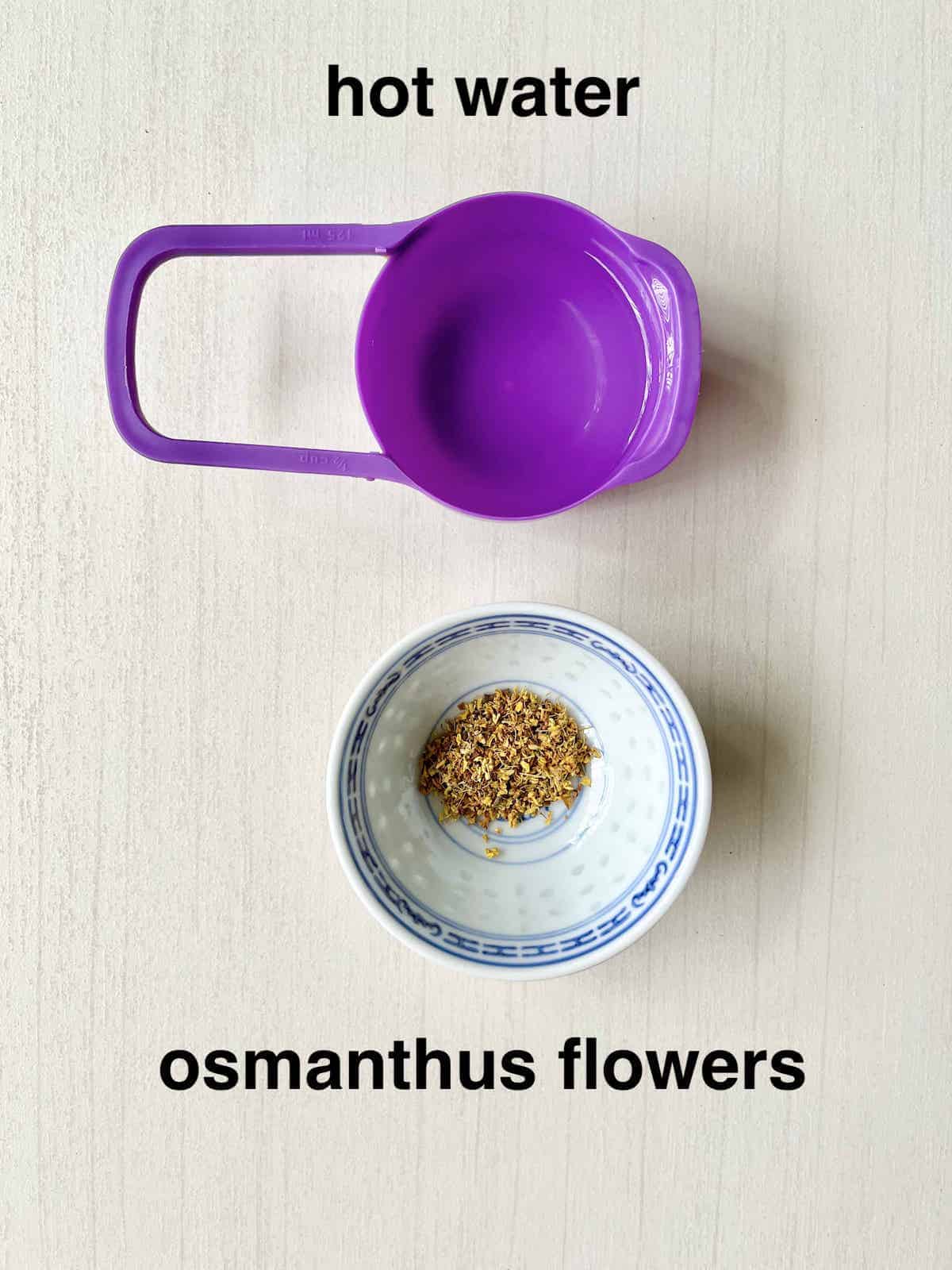
You only need 2 ingredients to make this golden tea:
- osmanthus flowers: I recommend washing them before brewing your tea. If you're not familiar with this process, see "Step-by-Step Instructions" below.
- hot water: ideally around 185F/ 85C as Chinese people don't believe in making tea with boiling water. If you're not fanatical about tea making, you don't have to use a food thermometer. Just leave the boiling water to cool slightly before using it to make tea!
However, if you like your food on the sweeter side, you can add a little neutral-flavored honey. (Osmanthus floral tea can be a bit bitter when concentrated.)
Note: A shortcut to making a sweetened version is to add hot water to osmanthus sugar or osmanthus syrup (which is basically the dried fragrant flowers + honey)
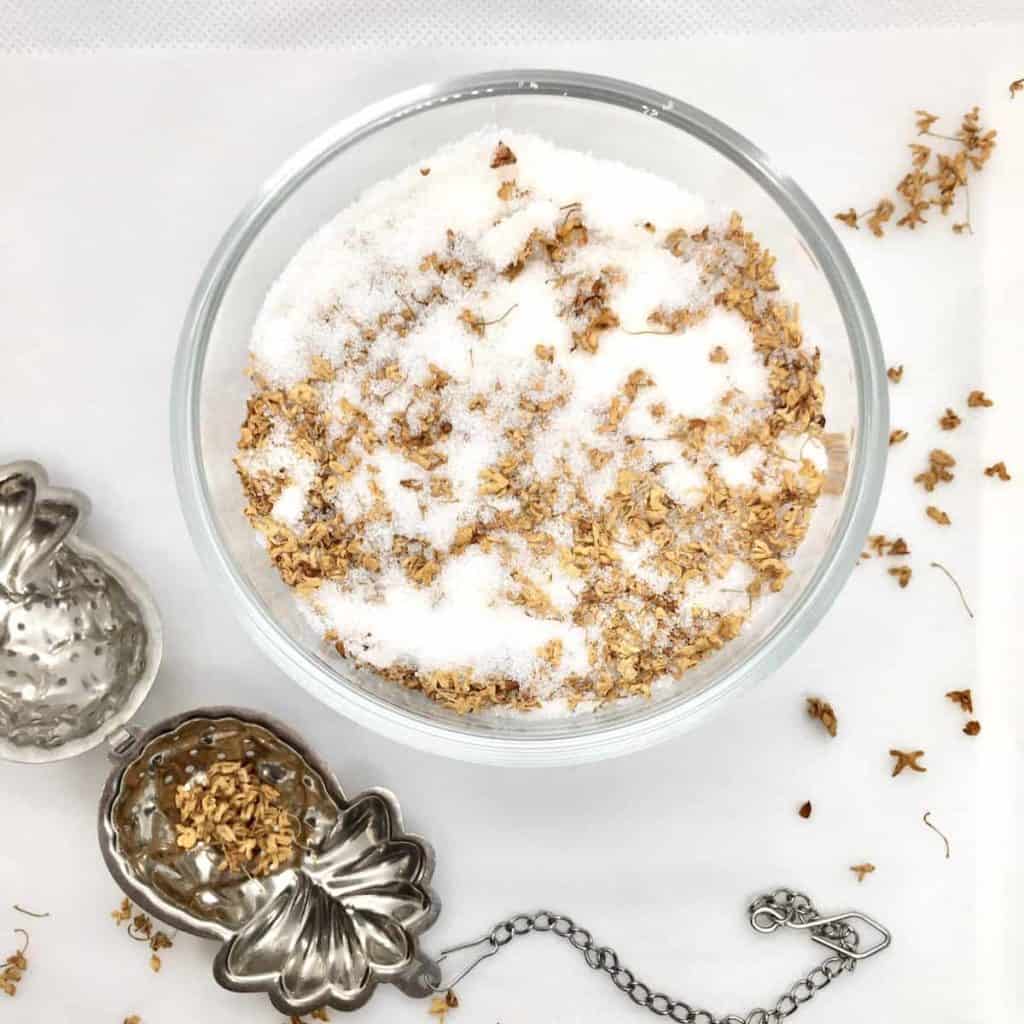
Variations
You can also blend the osmanthus tea with other tea leaves, to create:
- osmanthus oolong tea
- osmanthus chrysanthemum tea (caffeine-free)
- osmanthus rose tea (caffeine-free)
- osmanthus sencha/ sweet osmanthus green tea
- osmanthus pu erh tea
- osmanthus dragon well tea
- There are even milk tea/ bubble tea versions now!
Where to Buy
In Asian countries like Singapore, Malaysia, Hong Kong, Taiwan and China, this Chinese flower tea is stocked in many supermarkets, Chinese pharmacies, online, the wet market etc.
However, even in a country with as large a Chinese population as Singapore, it is still considered a bit of a speciality product. Hence, it may be out of stock in generic grocery stores.
In the United States, Chinese medicine stores are your best bet as they usually keep ready stock as well as bring in better quality osmanthus flowers. (These will have fewer impurities such as branches amongst the Dried Golden Osmanthus Blossoms)
If not, you can always find osmanthus flower tea online!
Note: You may think that they're all the same, but they're not! When my friend made osmanthus jelly using dried flowers she'd bought from a neighbourhood shop, she said they didn't taste as good as mine, which was made with osmanthus from a TCM shop (even though we used the same super easy osmanthus jelly recipe)!
Step-by-step Instructions
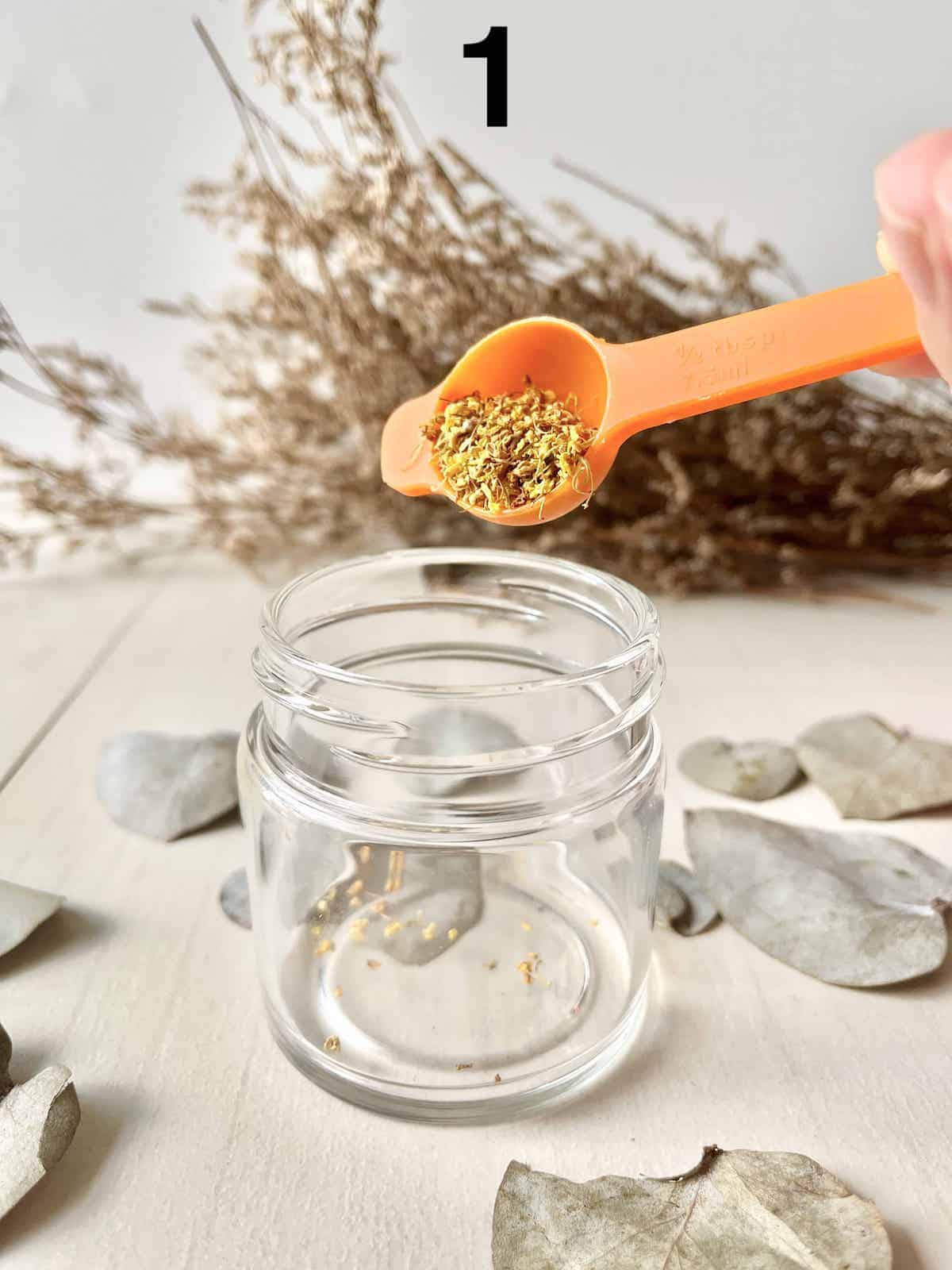
- Washing the tea leaves is an optional step but highly recommended as who knows how much dirt and dust the flowers have picked up whilst drying!
- Scoop 1 teaspoon of osmanthus buds into a heat-proof cup with a sieve-lid (or tea infuser.)
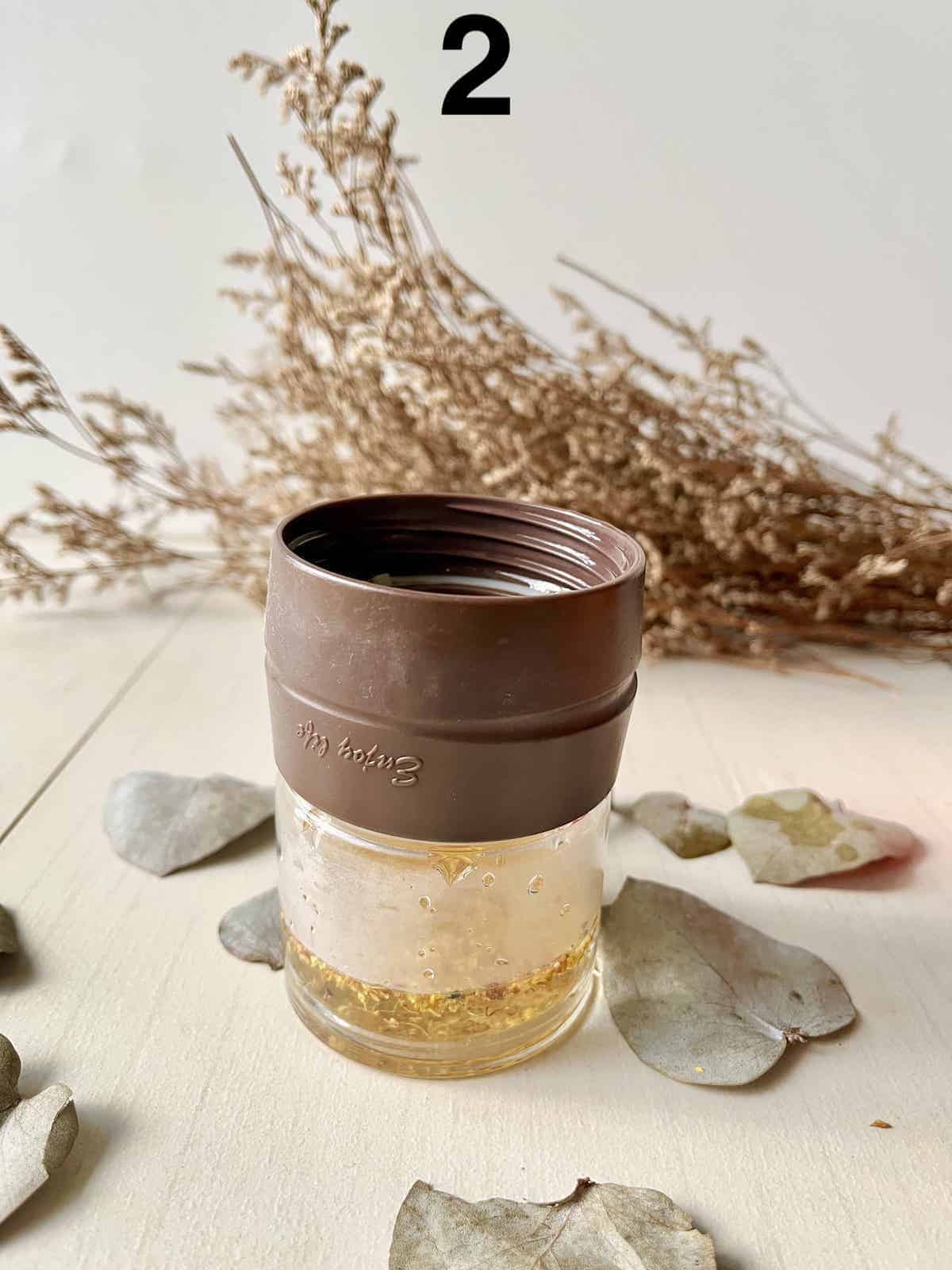
3. Pour some hot but not boiling water over the flowers and swish it around.
Note: I don't recommend washing the osmanthus flowers in a regular strainer as they're very small and will end up sticking to the strainer.
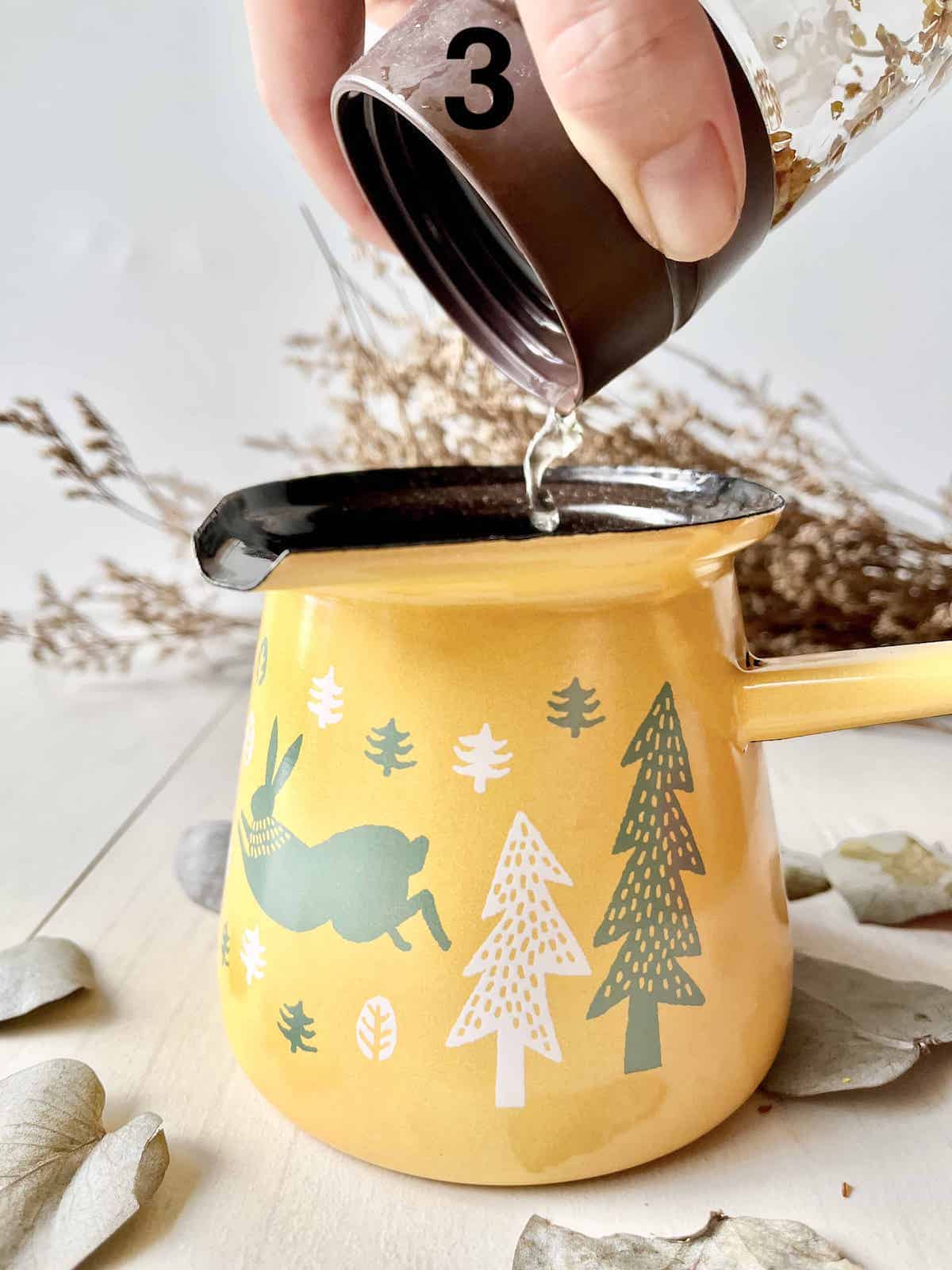
4. Immediately pour out the water. (This is the 1st rinse of the tea which is usually not drunk by Chinese people.)
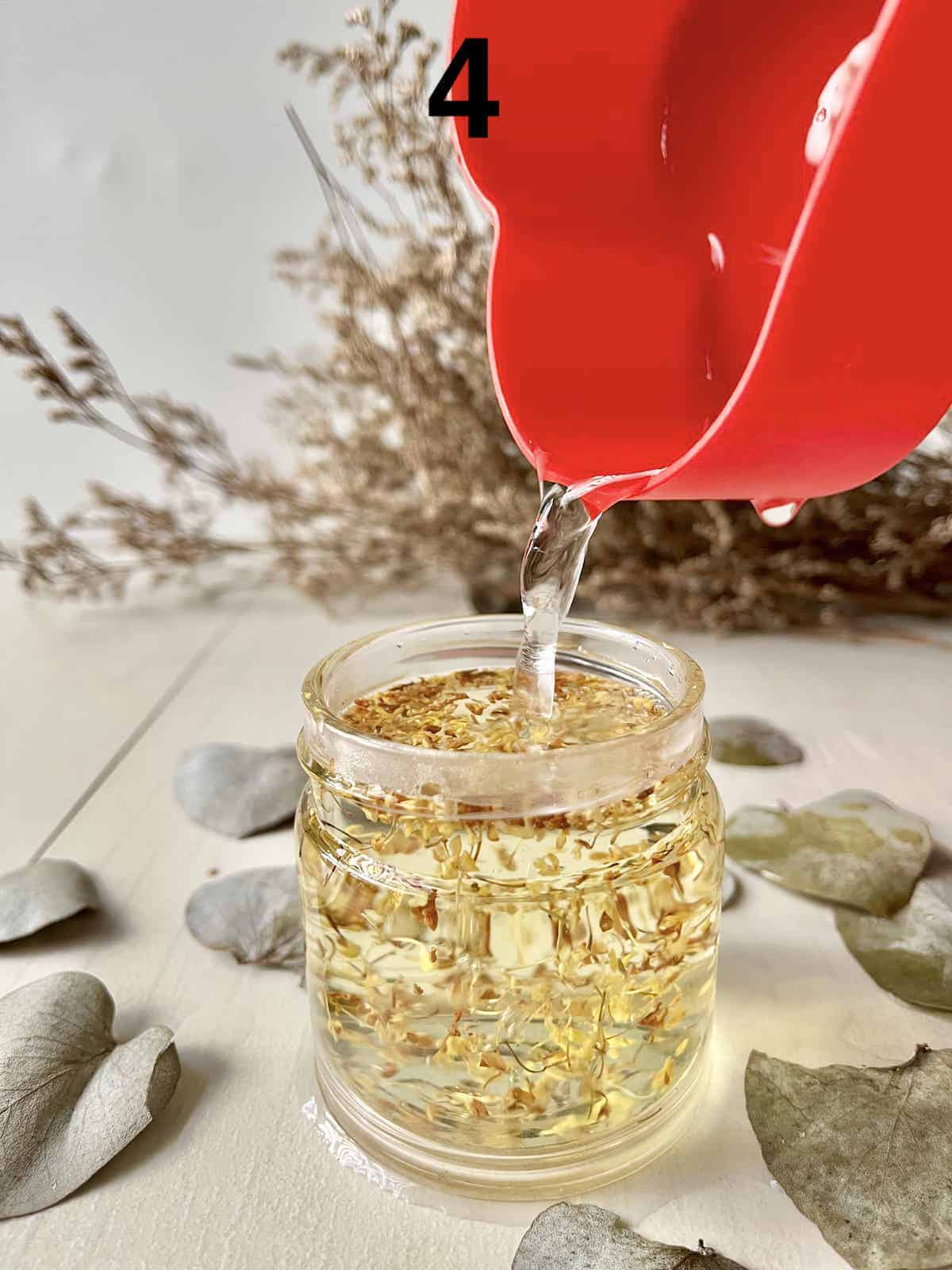
5. Pour 1 Cup of hot (but not boiling) water, ideally 185F/ 85C, over the same osmanthus flowers.
Let the tea steep for 2-3 minutes or to taste. Enjoy with some osmanthus cake on the side.
Optional: you can strain out the flowers if you want but they're edible.
How to Store
These golden flowers get moist easily so make sure to keep them airtight containers. (Toss in 1 of the dehumidifying food-grade packs, if you have them.)
It's generally recommended to use any osmanthus tea you have within 1 year but I confess I don't always do that. (Best before dates are guides not hard and fast rules, after all.)
Do toss if you notice it's moist or if you see any mold!
Expert Tips
Tip #1: Traditionally, osmanthus comes loose as dried golden flowers, and not in a tea bag. Some upmarket tea companies are starting to sell it in tea bag form but I don't recommend those as they're more expensive and bad for the environment.
Tip #2: The golden blossoms are so pretty floating in the water- add a couple of golden flowers back to the cup for visual effect!
Tip #3: Use a clear glass cup (which can withstand heat) to best admire the blossoms!
Recipe FAQs
As there is no caffeine, you can drink pure osmamthus tea anytime! (Make sure it's not blended with other caffeinated teas.) There have been reports linking 1 daily cup of osmanthus tea with increased anti-oxidant defenses. (But everything in moderation, remember!)
There are several ornamental varieties. However, the species used in cooking and to make tea can be eaten. However, it can be a bit fibrous so I suggest no more than a couple of buds per cup!
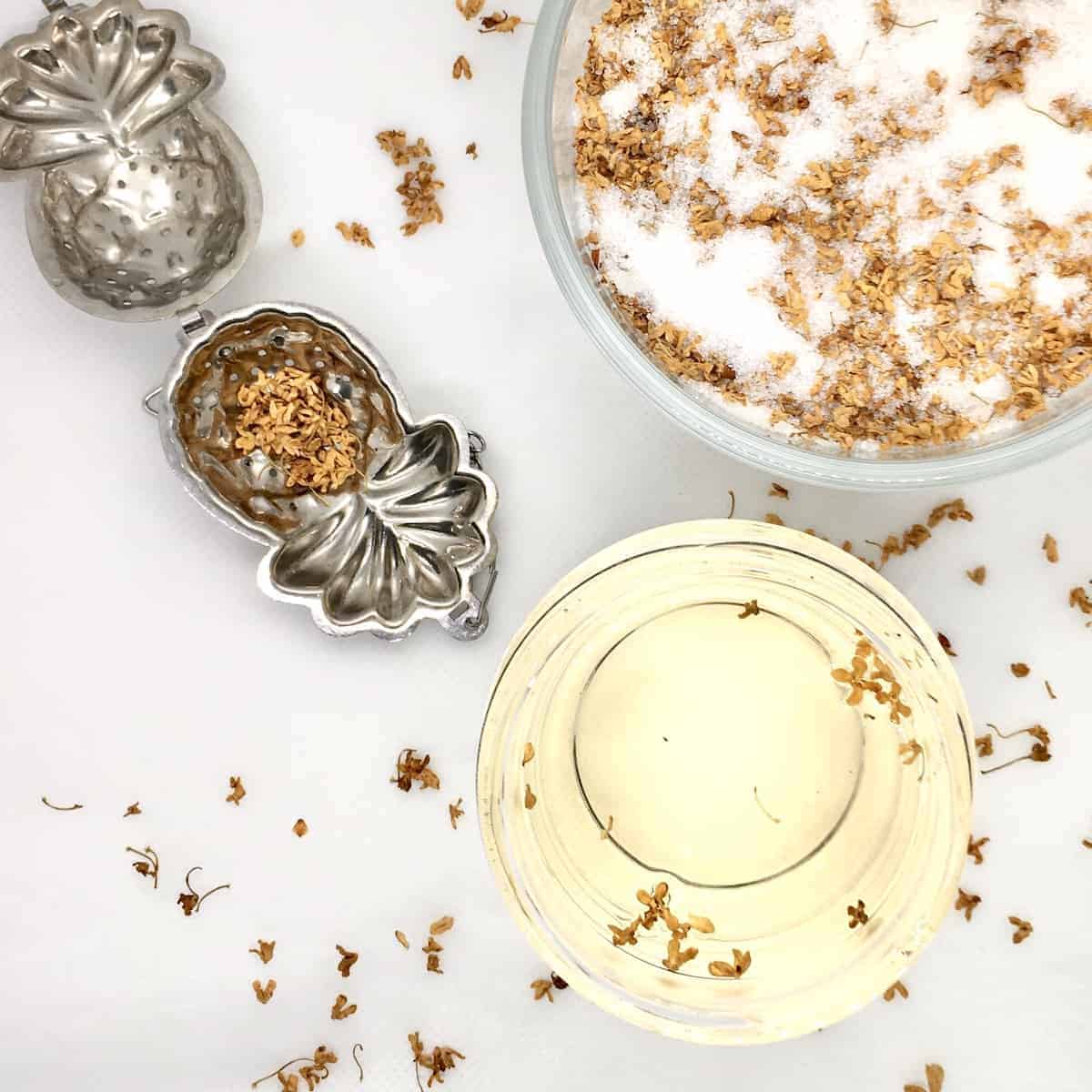
Other Traditional Chinese Recipes
Enjoyed this Healthy Osmanthus Tea recipe? Please leave a 5-star 🌟🌟🌟🌟🌟rating in the recipe card below & if you REALLY like it, I'd love a comment. Thank you!
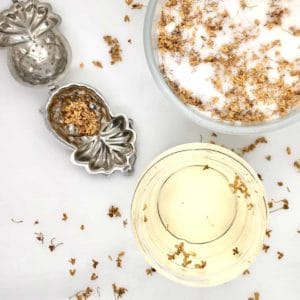
Golden Osmanthus Tea (Gui Hua Cha)
Equipment
- Heat-proof Cup
- Tea strainer or sieve
Ingredients
Pure Osmanthus Tea (Plain)
- 1 teaspoon dried osmanthus flowers
- 1 Cup water at 185F/ 85C Chinese people don't believe in making tea with boiling water. If you're not fanatical about tea making, you don't have to use a thermometer- just leave the boiling water to cool slightly before using it to make tea!
Pure Osmanthus Tea (Sweetened)
- 1 teaspoon dried osmanthus flowers
- 1 Cup water at 185F/ 85C As above
- Either osmanthus sugar, honey or rock sugar, to taste
Osmanthus Oolong Tea
- 1 teaspoon dried osmanthus flowers
- 2 teaspoon dried oolong tea leaves
- 1 Cup water at 185F/ 85C As above
Osmanthus Green Tea
- 1 teaspoon dried osmanthus flowers
- 2.5 teaspoon dried green tea leaves
- 1 Cup water at 185F/ 85C As above
Instructions
Pure Osmanthus Tea (Plain)
- Bring water to the boil and let it cool. If you like to be exact, use a thermometer to make sure the water is 85C/ 185F before making tea
- Place the dried flowers in a tea strainer and run through with hot water (i.e. you're washing the tea "leaves" to get rid of any dirt any dust on it)
- Add 1C of 85/ 185F water to the dried flowers and leave to steep, to taste. (I usually leave it about 2-3 minutes) The longer you steep the flowers, the stronger the flavour and the more golden the colour.
- If you're a visual person, add a few osmanthus blossoms to the cup!
Pure Osmanthus tea (Sweetened)
- Repeat the above steps, but add some sweetener to taste, such as rock sugar or honey. You can also use natural sweeteners such as dried longans, wolfberries and red dates. Note that they're all warming, according to TCM, so taking too much is not advisable as it would put the body out of balance. (Too much heaty foods can lead to sore throats and acne.)
Osmanthus Oolong Tea
- Repeat the steps for Osmanthus Tea (Pure) but add the oolong tea leaves to the osmanthus flowers in the strainer.
Osmanthus Green Tea
- Repeat the steps for Osmanthus Tea (Pure) but add the green tea leaves to the osmanthus flowers in the strainer.
Notes
Note: the nutritional information is an estimate automatically calculated using the WPRM recipe maker and I am not responsible for its veracity.
Nutrition
What are some of your favourite tea flavours? Don't forget to tag me on social media (@greedygirlgourmet) if you try this Chinese Gui Hua Cha recipe!

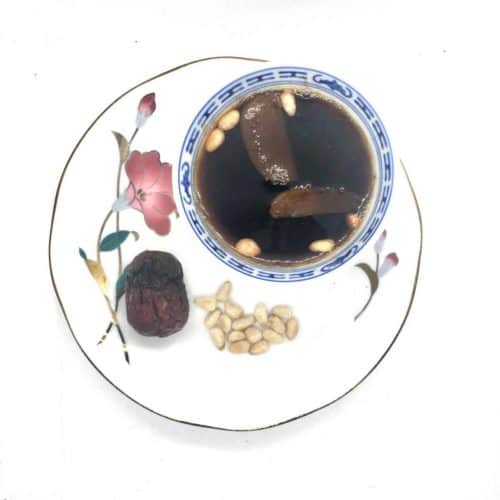
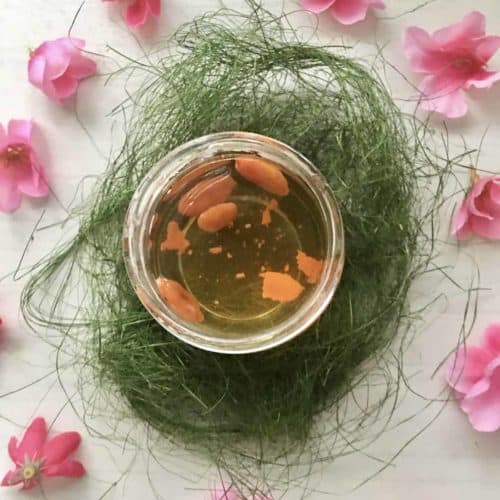

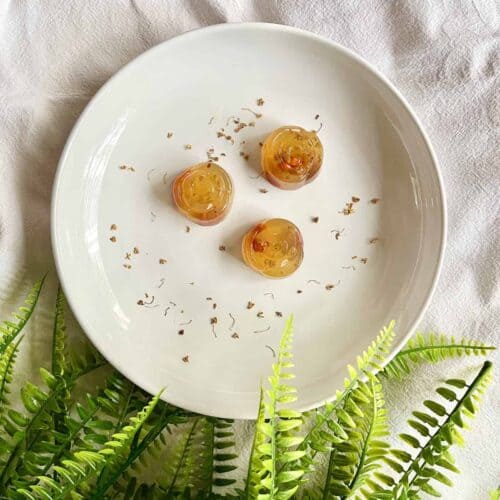
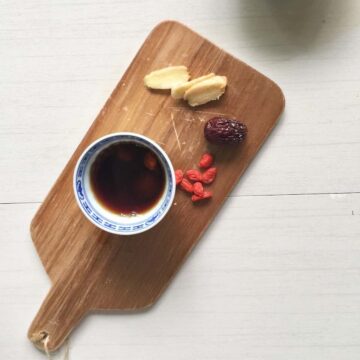
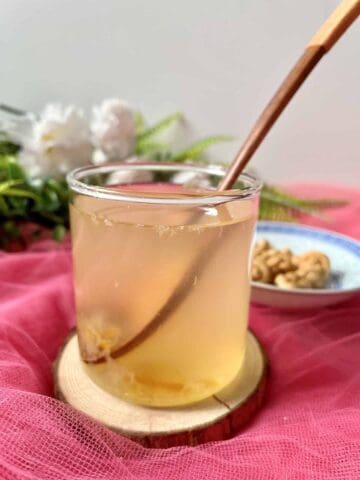
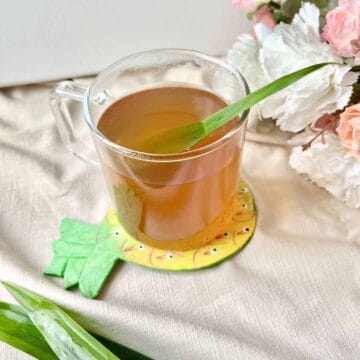
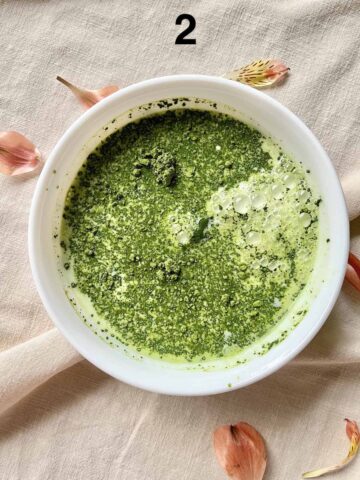
Charlie says
Tried with the long and and was delicious!
Zen says
I'm guessing u mean longjing (thanks Spellcheck :P)?! Glad u found ti good!
Belle says
Wow I never realised there are so many ways to drink osmanthus tea- always had it alone. Thanks for sharing, will try mixing with green tea or other Chinese tea leaves!
Zen says
Let me know if you prefer it plain or mixed! 🙂 I like mine pure